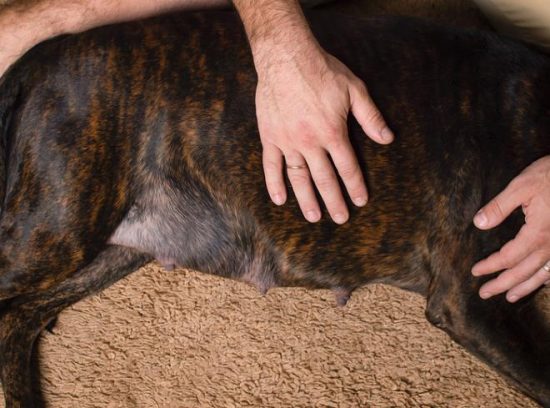How Long Are Dogs Pregnant? Get Facts About Dog Gestation
How long are dogs pregnant? Get the facts on dog gestation periods, from conception to whelping, and learn what to expect during your pup’s pregnancy.

Did you know that the average dog gestation period is just 63 days, a mere fraction of the 9-month human pregnancy? This relatively short timeframe underscores the importance of understanding the nuances of canine reproduction. Knowing the length of a dog’s pregnancy and the stages involved is crucial for the health and wellbeing of both the mother and her puppies. From conception to delivery, every day counts when it comes to monitoring a pregnant bitch and ensuring a successful outcome.
The normal gestation period in dogs is approximately 63 days from conception, although this can vary by several days. Pregnancy in dogs is relatively short compared to humans, about 9 weeks total, and each day matters. Knowing the length of the gestation period is important for the health of the pregnant bitch and the puppies and is used to monitor nutrition and veterinary care during pregnancy.
Sperm can live for several days inside the female, and eggs can remain fertile for up to 48 hours, which makes it hard to predict the length of pregnancy without the assistance of a veterinarian. Hormone measurements give a much more exact time frame for gestation. Many breeders use vaginal smears and blood tests to monitor reproductive hormones during the breeding process, which helps them determine the best time to breed their bitch, as well as the length of gestation and the potential due date.
Understanding the Dog Reproductive Cycle

Intact female dogs go into heat approximately every six months, although this can vary depending on the dog and the breed. The heat cycle lasts 18-to-21 days and is broken into four distinct stages: Proestrus, Estrus, Diestrus, and Anestrus. Understanding these stages of the dog reproductive cycle is crucial for knowing how long dogs are pregnant, as well as when they can become pregnant again.
Proestrus
Proestrus is the first stage of the dog reproductive cycle, lasting approximately 7 to 10 days. During this phase, the female dog’s body prepares for potential mating. The most notable signs include a swollen vulva and a bloody vaginal discharge. Behavioral changes also occur, such as increased restlessness and attraction to male dogs, although the female will not yet allow mating. Hormonal shifts, particularly an increase in estrogen, trigger the physical and behavioral changes observed during proestrus.
Estrus
Estrus, often referred to as the “heat” phase, follows proestrus and lasts about 5 to 10 days. This stage is characterized by the female’s receptivity to mating, indicated by a softer and more enlarged vulva and a change in the vaginal discharge to a clearer, straw-colored fluid. Hormonal changes, specifically a peak in luteinizing hormone (LH) and subsequent rise in progesterone, signal ovulation, making this the optimal period for successful mating and fertilization. Behavioral cues, such as flagging (raising the tail) and standing for the male, further indicate the female’s readiness to mate.
Diestrus
Diestrus is the phase following estrus, lasting approximately 60 to 90 days in non-pregnant dogs and until parturition (about 63 days) in pregnant dogs. During this stage, progesterone levels dominate, whether or not pregnancy occurs. In pregnant dogs, diestrus supports embryo implantation and fetal development. For non-pregnant dogs, the body behaves as if it is pregnant due to the high progesterone levels, leading to possible signs of pseudopregnancy, such as nesting behavior and mammary gland enlargement. During diestrus, the female is no longer receptive to mating.
Anestrus
Anestrus is the final stage of the reproductive cycle, characterized by sexual and hormonal inactivity. This period, lasting about 4 to 6 months, allows the dog’s body to recover and prepare for the next reproductive cycle. Hormone levels remain low, with no signs of estrus or reproductive activity. Anestrus provides a time for the reproductive tract to rest and regenerate, ensuring the dog is in optimal health for future cycles. This stage is crucial for maintaining the overall reproductive health and well-being of the dog.
How to Tell if a Dog Is Pregnant
Several methods can be used to determine if a dog is pregnant, each with its own advantages and timeframes. Veterinarians use four primary techniques to diagnose canine pregnancy: hormone tests, palpation, X-ray, and ultrasound.
Hormone Tests
Hormone tests, specifically the relaxin test, are a reliable method to determine if a dog is pregnant. Relaxin is a hormone produced by the placenta and becomes detectable in the bloodstream around 21 to 28 days after mating. The veterinarian draws a small blood sample from the dog and tests it for the presence of relaxin. This test is highly accurate when performed at the appropriate time, providing early and clear confirmation of pregnancy without invasive procedures.
Palpation
Palpation is a hands-on technique used by veterinarians to feel for developing puppies in a dog’s abdomen. This method is typically performed between 28 and 35 days after mating, when the fetuses can be felt as small, firm lumps. While palpation is a quick and cost-effective method that requires no special equipment, it is highly dependent on the veterinarian’s skill and experience and may be less effective later in pregnancy when the uterine sacs become more fluid-filled.
X-ray

X-rays are a definitive method for confirming pregnancy and counting the number of puppies in a dog, typically performed around 45 days after mating when the puppies’ skeletons are visible. During the procedure, the dog is positioned on a radiographic table, and X-rays are taken of the abdomen. X-rays provide clear images of the developing puppies, allowing for accurate counting and assessment of their size and position, although the procedure involves exposure to radiation, which is generally considered safe in small doses.
Ultrasound
Ultrasound is a widely used and effective method for detecting pregnancy in dogs, capable of providing early confirmation as well as detailed information about the health and development of the puppies. Performed as early as 25 to 30 days after mating, ultrasound uses sound waves to create images of the developing embryos on a monitor. This non-invasive procedure can detect heartbeats, assess the viability of the pregnancy, and help estimate the due date, although it may not accurately count the number of puppies.
How Long Are Dogs Pregnant?
The normal gestation period in dogs is approximately 63 days from conception, although this can vary by several days. Pregnancy in dogs is relatively short compared to humans, about 9 weeks total, and each day matters. Knowing the length of the gestation period is important for the health of the pregnant bitch and the puppies and is used to monitor nutrition and veterinary care during pregnancy.
Sperm can live for several days inside the female, and eggs can remain fertile for up to 48 hours, which makes it hard to predict the length of pregnancy without the assistance of a veterinarian. Hormone measurements give a much more exact time frame for gestation. Many breeders use vaginal smears and blood tests to monitor reproductive hormones during the breeding process, which helps them determine the best time to breed their bitch, as well as the length of gestation and the potential due date.
Stages of Dog Pregnancy

As the gestation period in dogs is relatively short, spanning around 9 weeks, the stages of pregnancy progress quickly. During the first month, the
embryos travel to the uterine horns and are embedded in the uterine lining, with the fetus beginning to take shape by day 22 and fetal heartbeats detectable around day 28 or 30. Many dogs do not show any obvious symptoms during the first three weeks of their pregnancy.
Month One
The first month of a dog’s pregnancy is a crucial time, as the embryos make their way to the uterine horns and begin to implant in the uterine lining. By day 22, the fetus starts to take shape, and by days 28 or 30, fetal heartbeats can be detected. However, many pregnant dogs do not display any noticeable signs during this initial stage.
Month Two
As the dog enters the second month of pregnancy, fetal development accelerates rapidly. By day 32, the puppies’ eyelids begin to form, and by day 35, their tiny toes become visible. Claws start to develop around day 40, followed closely by the formation of the coat and skeleton. During this stage, the signs of pregnancy in the bitch become much more apparent.
Month Three
By the third month, the pregnant bitch is nearing the end of her gestation period and preparing to whelp. Puppy development is almost complete by around day 58, and in the final days, the puppies begin to move into the whelping position in the birth canal, ready to make their entrance into the world.
How Long Are Dogs in Labor?
Once the gestation period is over, labor begins, with three distinct stages of labor. Understanding the typical duration and progression of these stages can help dog owners be prepared and know when to seek veterinary assistance if complications arise.
The first stage of labor in dogs lasts 12-to-24 hours and is often not outwardly noticeable. During this stage, the contractions in the muscular wall of the uterus gradually increase, laying the groundwork for the actual delivery of the puppies.
The second stage is when the puppies are delivered, and this can take anywhere from 1-to-24 hours, with each individual puppy delivery occurring every 30-to-60 minutes. This is the active birthing phase where the mother dog will expend significant energy to push the puppies out.
The final stage of labor is the delivery of the placenta, which usually occurs shortly after the last puppy is born. This stage is relatively quick and completes the whelping process.
It is recommended to contact a veterinarian if a dog’s labor takes more than 24 hours or if more than 2 hours pass in between puppies, as this could be a sign of a serious complication that may require medical intervention, such as a cesarean section. Monitoring the how long are dogs pregnant and being attentive to the labor stages can help ensure the health and safety of both the mother dog and her puppies.
Preparing for Your Dog’s Pregnancy
To prepare for your dog’s pregnancy, it is recommended to create a quiet, relaxing, and private space for your dog to give birth and nurse puppies in, such as a large cardboard box or whelping box lined with puppy pads and clean bedding. Gather clean towels, nail scissors, and small blankets, and have microwavable bean bags on hand to provide warmth if needed. It is also important to know the signs of labor and distress to look out for, and to have your veterinarian’s emergency contact information readily available, as dogs often give birth at night and sometimes an emergency cesarean is required.
Preparing for your dog’s how long are dogs pregnant and ensuring a comfortable, safe environment for the birthing process is crucial for the health and wellbeing of both the mother and her puppies. By taking the necessary steps ahead of time, you can help make the delivery and postpartum period as smooth and stress-free as possible. Additionally, being aware of the how soon can you tell if your dog is pregnant? signs can help you monitor your dog’s progress and take proactive measures to support her throughout the pregnancy.
Diet and Nutritional Needs During Pregnancy

After mating, a dog’s food intake should remain the same during the first two-thirds of pregnancy (approximately six weeks after mating), and it is recommended to feed a premium, high-quality diet approved by a veterinarian that is appropriate for “gestation and lactation” or “all life stages” and contains high levels of omega-3 fatty acids (DHA) to support puppy development.
Last Three Weeks of Pregnancy
After the sixth week of pregnancy, a dog’s food intake should gradually increase, as the fetuses grow and abdominal pressure increases, with smaller, more frequent meals advised. During the last three weeks of pregnancy, a dog’s food intake should increase by up to one and a half times the normal level to help support the dog’s health and body condition while in the final stages of pregnancy and producing milk after whelping.
Medications and Supplements During Pregnancy
Some commonly used medications should be avoided while a dog is pregnant, and it is recommended to contact a veterinarian to discuss the use of any supplements and medications. Certain supplements, such as those containing high levels of omega-3 docosahexaenoic acid (DHA), have been shown to improve the health and development of puppies and may be recommended by a veterinarian during a dog’s pregnancy. It is important to follow a veterinarian’s guidance when it comes to administering any medications or supplements to a pregnant dog to ensure the safety of both the mother and the developing puppies.
Signs of Dog Pregnancy
Detecting the signs of dog pregnancy can be a delicate process, as the early indicators can be quite subtle. As the pregnancy progresses, however, more obvious signs begin to emerge. By understanding the various stages and monitoring for these changes, pet owners can better prepare for the arrival of their canine companions’ new litters.
Early Signs
In the initial stages of pregnancy, a dog’s appetite may change, with some experiencing increased hunger while others show a decreased interest in food. Slightly enlarged nipples and a clear vaginal discharge are also early indicators that a dog may be pregnant. Additionally, pregnant dogs often display increased tiredness and become more affectionate towards their owners.
Later Signs
As the pregnancy progresses, more pronounced signs begin to manifest. These can include significant weight gain, a further increase in appetite, and noticeable behavioral changes. The dog’s teats may darken and become more prominent, and a semi-clear discharge may be present. One of the clearest signs during the latter stages is an enlarged abdomen, with the movement of the developing puppies often visible from the outside.
It is crucial to monitor for these signs and consult a veterinarian if a dog’s pregnancy is suspected. Early detection can help ensure the health and well-being of both the mother and her future litter.
Caring for a Pregnant Dog

As a dog’s pregnancy progresses, intra-abdominal pressure increases, and so do the mother’s food requirements. It’s important to feed the dog smaller, more frequent meals rather than increasing the quantity per meal. When it comes to physical activity, it’s best to let the pregnant dog decide how much she needs, as this will depend on the number of puppies and the intra-abdominal pressure she is experiencing. Overexercising a pregnant female should be avoided.
When it comes to physical activity, it’s best to let the pregnant dog decide how much she needs, as this will depend on the number of puppies and the intra-abdominal pressure she is experiencing. Overexercising a pregnant female should be avoided.
Towards the end of the pregnancy, the dog will start exhibiting nesting behavior, such as pacing, panting, shivering, or digging, as she prepares for the arrival of her puppies. Providing a quiet, comfortable space for the dog to nest and give birth is crucial.
FAQs on how long are dogs pregnant
How many months can a dog be pregnant again?
Intact female dogs go into heat approximately every six months, although this can vary depending on the dog and the breed. The time frame between one heat cycle and the next is called anestrus and usually lasts around six months.
How soon can you tell if your dog is pregnant?
There are four methods veterinarians can use to determine if a dog is pregnant: hormone tests, palpation, x-ray, and ultrasound. Veterinarians can test for the hormone relaxin to determine if a bitch is pregnant, but the bitch must be at least 30 days into her gestation for the test to be accurate.
How many times can a dog get pregnant in a year?
Intact female dogs go into heat approximately every six months, although this can vary depending on the dog and the breed. The time frame between one heat cycle and the next is called anestrus and usually lasts around six months.
How many times can a female dog mate in one day?
Sperm can live for several days inside the female, and eggs can remain fertile for up to 48 hours, which makes it hard to predict the length of pregnancy without the assistance of a veterinarian.
Will a male dog still mate if a female is pregnant?
Sperm can live for several days inside the female, and eggs can remain fertile for up to 48 hours, which makes it hard to predict the length of pregnancy without the assistance of a veterinarian.
Do dogs give birth at night?
Dogs often give birth at night, and sometimes an emergency cesarean is required, so it is important to have your veterinarian’s emergency contact information readily available.
What animal is pregnant the longest?
The normal gestation period in dogs is approximately 63 days from conception, which is relatively short compared to humans. The animal with the longest gestation period is the African elephant, with a pregnancy lasting around 22 months.
How many puppies can a dog give birth to for the first time?
The number of puppies a dog can give birth to for the first time can vary widely, depending on the breed and the individual dog. On average, first-time mothers typically have smaller litters, often between 3-6 puppies.





